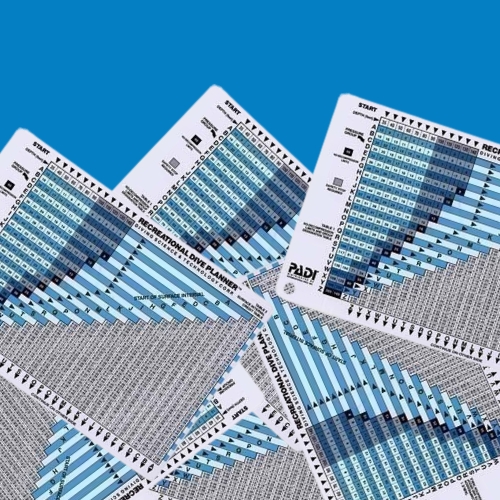
Alright, divers, let's talk about those mysterious dive tables – the ones that look like a cryptic crossword puzzle crossed with a spreadsheet from your accounting class. They might seem intimidating at first, but fear not! Understanding dive tables and no-decompression limits (NDLs) is crucial for safe and enjoyable scuba diving.
Think of it this way: dive tables are like your underwater roadmap, helping you navigate the depths and avoid those pesky decompression stops (more on those later). They might not be as exciting as spotting a manta ray, but they're definitely more important for your safety.
So, grab your dive slate and let's decode those tables together!
The Basics: What Are Dive Tables and No-Decompression Limits?
Dive tables are a set of guidelines that tell you how long you can stay at a certain depth without needing to make decompression stops during your ascent. These stops are necessary to allow your body to safely release excess nitrogen that accumulates during a dive. Too much nitrogen, and you risk getting the bends (decompression sickness), which is about as fun as it sounds.
No-decompression limits (NDLs) are the maximum amount of time you can spend at a given depth without incurring a decompression obligation. In other words, they tell you how long you can stay down and still come up directly to the surface without needing to make any stops along the way.
How to Read a Dive Table (It's Easier Than You Think!)
Dive tables might look complicated, but they're actually pretty straightforward once you understand the basics. Most tables have two main sections:
- No-Decompression Limits Table: This table shows the maximum bottom time allowed for various depths.
- Repetitive Dive Table: This table helps you calculate your no-decompression limits for subsequent dives on the same day, taking into account any residual nitrogen from previous dives.
Here's a breakdown of how to use dive tables:
- Determine your planned depth: Look at the depth column on the left side of the no-decompression limit table. Find the depth that most closely matches your planned dive depth.
- Find your bottom time: Once you've identified your planned depth, follow that row across to the right until you reach the column that corresponds to the total time you plan to be underwater. The number at the intersection of your depth and time is your maximum bottom time (MBT).
- Rounding up: It's crucial to always round up your depth and time to the next highest value on the table. For example, if your planned depth is 72 feet, round up to 80 feet. If your planned bottom time is 32 minutes, round up to 35 minutes. This ensures you're being conservative and staying within safe limits.
- Repetitive dives: If you're planning multiple dives on the same day, you'll need to use the repetitive dive table. This table takes into account the residual nitrogen in your body from previous dives, which can affect your no-decompression limits for subsequent dives.
Here's an example: You plan to make two dives on the same day. Your first dive is a 30-minute dive at 60 feet. According to the no-decompression limit table, your MBT for this dive is 45 minutes. You have a surface interval of 2 hours before your second dive, which will be at 70 feet. To calculate your MBT for the second dive, you'll need to use the repetitive dive table. Find the row for your first dive's depth and time (60 feet, 30 minutes) and then find the column for your surface interval (2 hours). The number at the intersection of these two points is your residual nitrogen group. Use this number to find your MBT for the second dive on the repetitive dive table.
Dive Computers: Your Digital Dive Buddy
Nowadays, most divers use dive computers, which do all the calculations for you in real-time. They're like having a personal dive guide on your wrist, constantly monitoring your depth, time, and nitrogen levels to ensure you stay within safe limits.
But even with a fancy dive computer, it's still important to understand the basic principles of dive tables and no-decompression limits. What if your computer malfunctions? Or what if you want to plan your dives ahead of time? Knowing how to use dive tables is an essential skill for every diver.
Factors Affecting No-Decompression Limits
Your NDLs aren't set in stone – they can vary depending on a few factors:
- Depth: The deeper you go, the shorter your NDL becomes.
- Repetitive Dives: Residual nitrogen from previous dives reduces your NDL for subsequent dives.
- Exertion: Strenuous activity can increase your nitrogen absorption, potentially shortening your NDL.
- Age and Fitness: While age alone will not impact your NDL, you should always be conscientious about your overall health when diving.
Safety First: Diving Within Your Limits
Remember, dive tables and dive computers are just guidelines. It's always best to err on the side of caution and stay well within your no-decompression limits. If you're unsure about anything, ask your dive instructor or a qualified professional.
Dive Right In Scuba: Your Dive Planning Partner
At Dive Right In Scuba, we're passionate about helping you plan safe and enjoyable dives. We offer a variety of dive courses, including refresher courses on dive tables and dive computer use. Our knowledgeable staff can also help you interpret your dive computer data and make informed decisions about your dives.
Decode the Tables, Dive with Confidence
Understanding dive tables and no-decompression limits is like learning a new language – it might take some practice, but it's worth it. By mastering these essential skills, you'll be able to plan your dives confidently, stay within safe limits, and avoid any unwanted surprises. So, grab those tables, dust off your calculator, and let's decode the secrets of decompression!
